
The Ultimate Guide to Emoji Domains
Whether you’re an emoji domain expert or this is the first time you’ve heard about emoji domains, we hope the information provided below helps you navigate this new emoji marketing landscape.
But first, a quick answer as to why? Why would you want an emoji domain?
Emoji domains aren’t supposed to replace anything you’ve come to regard as normal. We’re not expecting you’ll let Pizza.com expire to replace it with  .ws!
.ws!
A domain name is a branding tool and a place on which to build something. But, just like physical real estate, you wouldn’t build a shop and hope people walk past. Instead, you’d try all sorts of creative endeavors to engage people and entice them in.
A domain name is the modern, digital equivalent of the shop.
Emoji domains are the modern, digital equivalent of the creative and engaging marketing endeavor.
Modern marketing requires an omni-channel approach. That is to say, a business must be marketing itself across multiple platforms and in various ways to achieve success. If you now re-evaluate emoji domains under this guise and see them as an additional way to attract and engage customers, they make sense.
They make sense because they offer wildly different properties to any other form of domains. Here’s a short list to get you thinking:
- They are pictures.
- They are colorful.
- They are on more smartphone keyboards than any other single language.
- People love emoji!
These properties combined are unique to only one form of navigable internet infrastructure- emoji domains.
We’ll run through why emoji domains, apart from being a lot of fun, are valuable to businesses later on but first let’s address something important.
Why Now?
The way emoji domains are brought to life has had an impact on why emoji domains are only recently beginning to see their deserved limelight and why they may not have crossed your radar.
New technology usually has its mainstream moment when the UX is made simple and recognizable for the average person. Imagine the deep complicated layers that make up the internet and how it has evolved to a point where things are delivered to us in nice simple forms. Click this button, stream this video, download this file, communicate with these billion people at once for example.
25 years ago well respected, intelligent people voiced their doubt about the internet’s viability. Yet, here you are today reading this information, maybe even on your phone.
You don’t need to care about understanding the underlying code that makes it all work, because it works so well. The same applies to emoji domains. When you see an emoji domain you don’t need to understand the underlying code (specifically called punycode) that allowed you to see the picture as intended.
What’s Punycode?
Well, punycode is interesting because it’s what stopped many people from even knowing you could register emoji domains. When you type an emoji in the browser, on a social platform or on a messaging app, the software is reading the emoji’s associated code to identify and display it. Using our tasty example from before, the pizza emoji has the unique punycode,
The punycode could have been registered with us or at popular registrars like GoDaddy. But, because punycode was not common knowledge, it just didn’t happen. This changed quite dramatically when a developer used a GoDaddy hackathon to make the UX simple and recognizable. The result was I❤.ws which allowed people to directly search the emoji from either a smartphone or by using an emoji keyboard on a Mac or PC. It seems simple now but the best ideas always do!
You can also translate any emoji into punycode using Punycoder.com
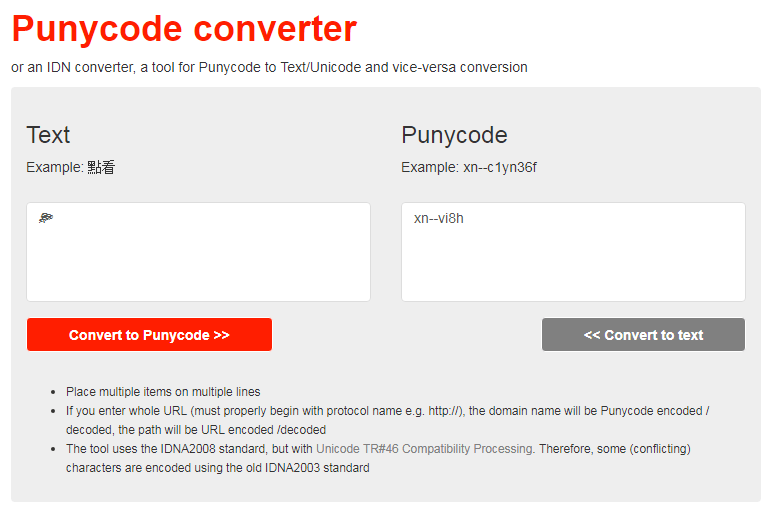
So, when you register an emoji domain and you see a string of letters and numbers starting with ‘xn -- ‘ you can be safe in knowing that this is just because software prefers code and we prefer pizza.
Who Uses Emoji Domains?
Some innovative companies with teams of intelligent, tech oriented staff were quick to register emoji domains that they felt represented their commodity, company or culture.
They weren’t start-ups looking for a gimmick though. These are some of the best known companies in the world and so by registering an emoji domain you’re in smart company.
 .ws is owned by Warby Parker
.ws is owned by Warby Parker .ws is owned by The MGM Grand
.ws is owned by The MGM Grand .ws,
.ws,  .ws and
.ws and  .ws are owned by Mailchimp
.ws are owned by Mailchimp
 .ws is owned by Sony Pictures
.ws is owned by Sony Pictures .ws is owned by Van Heusen
.ws is owned by Van Heusen .ws is owned by Frank Body
.ws is owned by Frank Body- ❤
 .ws is owned by Budweiser
.ws is owned by Budweiser  .ws is owned by Bevel
.ws is owned by Bevel
There are loads more small to mid-size companies embracing emoji domains too. So which emoji domain would work best for you and how do you go about selecting an appropriate one?
Choosing An Emoji Domain
There are a few ways to decide which emoji domains are going to suit your business.
The obvious one is if there is already an emoji that matches a product you sell. Warby Parker is a great example of this because they sell glasses and own  .ws.
.ws.
This too can also be said for Van Heusen ( .ws) who sell the product the emoji represents among other products that relate.
.ws) who sell the product the emoji represents among other products that relate.
But, it doesn’t have to end there or even remain that simplistic. Emoji are synonymous with creativity with several of the food emoji ( /
/ ) infamously denoting other things.
) infamously denoting other things.
The next level removed is to choose an emoji that represents the business you’re in. The MGM Grand ( .ws) doesn’t sell joker playing cards but it is in the casino business where cards play a part.
.ws) doesn’t sell joker playing cards but it is in the casino business where cards play a part.
Frank Body ( .ws) doesn’t sell shower heads but they started off with one shower related product- a coffee body scrub- and have rapidly expanded over the last 5 years.
.ws) doesn’t sell shower heads but they started off with one shower related product- a coffee body scrub- and have rapidly expanded over the last 5 years.
Bevel sell razors and men’s grooming accessories which nicely fall under the umbrella of the barber pole ( .ws)
.ws)
A further level removed can be demonstrated by what Mailchimp have done. The waving hand emoji  might suggest either getting attention or waving ‘hello’. Either way it nicely reflects what Mailchimp do, which is to allow their customers to say hello and get attention in their audience’s inbox. Although they own the emoji most associated with email too (
might suggest either getting attention or waving ‘hello’. Either way it nicely reflects what Mailchimp do, which is to allow their customers to say hello and get attention in their audience’s inbox. Although they own the emoji most associated with email too ( ) they don’t let that stop them creatively.
) they don’t let that stop them creatively.
Remember, if emoji domains are supposed to be a part of a marketing kit, then they should match the sentiment emoji inherently have which is fun and slightly quirky!
Take Norwegian Airlines, for example, who wanted to market their flights to Vegas. They determined the basic positive steps that a customer might imagine taking when thinking about flying to Vegas.
- You fly
- You gamble
- You win (We did say positive instead of realistic!)
They compiled these actions into emoji which resulted in the following emoji domain,
✈
 .ws
.ws
A triple combination like this where the elements clearly make sense to Norwegian Airline’s marketing campaign is a clever way to create an engaging emoji domain. Can you imagine seeing this on social media? Very engaging!
The 4 Cs
To help you begin choosing an emoji domain we recommend thinking about the four Cs of emoji domains:
- Commodity
- Company
- Culture
- Creative
Using the profession of wedding photographer we’ll run through the emoji domains each category might produce.
Commodity
Can you find an emoji domain that represents the product you sell?
In this case there is no single emoji that sums up the profession of wedding photographer.
Company
What industry is your company in?
There are multiple ways of expressing the entire wedding photography profession. Some of our favorites are:

 .ws
.ws
 .ws
.ws
 .ws
.ws
 .ws
.ws
Culture
What does your product or service represent?
Is there a higher, more abstract way of thinking about what you offer? Is there a cultural element to your industry or product that might mirror how you conduct your work. Is there an emoji domain that plays off your tagline or marketing material.
Creative
Can you combine multiple emoji to suggest a story?
What would the perfect wedding day capture? The wedding couple, the party, the love? How about
 ❤🤵
❤🤵
 ️.ws
️.ws
What about if you have a specific wedding photography niche. You can get creative with this too. If you market to foreign wedding couples marrying in Italy you could use


 .ws
.ws
or


 .ws
.ws
I❤ASCII
ASCII stands for the American Standard Code for Information Interchange. It denotes the typographical systems used to encode electronic communication. It is punycoding an emoji into ASCII characters that allows the emoji to be read, understood and displayed. At Global Domains International we pride ourselves on being at the forefront of modern digital communication by allowing both emoji and ASCII in the same URL. As you’ve seen, there are multiple ways to use emoji domains but this creative combination is something we wholeheartedly embrace.
Following the theme you might use something like
 photography.ws or wedding
photography.ws or wedding .ws
.ws
There are a whole host of new opportunities open to anyone who can think beyond the basics. A trend we’ve seen a lot of is the “I❤ + thing” emoji domains.
It makes sense because we’re already used to seeing iconic images like this whether it be I❤NY or I❤LA.
By tapping into an existing trend that already holds space in the minds of millions of consumers it’s likely they’ll engage with a URL that mirrors the effect. Can you imagine these URLs on social media, in push notifications or on messaging apps?
- I❤marketing.ws
- I❤coffee.ws
- I❤gaming.ws
- I❤data.ws
- I❤dancing.ws
- I❤you.ws
- I❤crypto.ws
Now the possibilities are truly endless…
- BeMy
 .ws
.ws - Dance
 .ws
.ws  Lessons.ws
Lessons.ws ️ForPresident.ws
️ForPresident.ws- Pizza🛵.ws
- Grocery
 .ws
.ws - Fake
 .ws
.ws - Britney
 .ws
.ws - ⛽Station.ws
 my
my .ws
.ws
You get the idea…
Why Should I Get An Emoji Domain?
Carry on reading to find out the reasons we have established as to why a company would want to communicate using emoji domains. Fundamentally, it is all about talking and acting the way your customers do.
Remember when companies thought it was a waste of time to have a presence on social platforms? Now, it is not surprising to hear of entrepreneurs building their businesses purely on social.
So, just like the advantages of social media were hidden to some 10 years ago, the same could be said of emoji domains now. The companies that embrace them now will have a head start on those that are skeptical.
Here’s why we think emoji domains are part of a modern marketer’s arsenal.
1. They Are So Short!
Short domains have long been desirable. A shorter, more authoritative domain is one that demands respects and carries authority. See the evolution from:
MarksEmailMarketingCourse.com
EmailMarketingCourse.com
EmailMarketing.com
Email.com
The fewer the letters the higher the domain name’s value and therefore price tag because with brevity you achieve specificity.
Now imagine emoji domains like

 .ws
.ws
 .ws
.ws
 .ws
.ws
 .ws
.ws
 ️.ws
️.ws
 .ws
.ws
 .ws
.ws
Could these extremely short domains carry the following sentiments?
- increase email open rates
- unlock the potential of email marketing
- increase your email subscribers
- king of email marketing
- email marketing tools
- email marketing PDF
- email marketing analytics
Marketing materials rarely stand alone so it’s likely these emoji would usually accompany some text that gives the emoji domain context. But, even if they were viewed independently, you could infer their intended meanings.
2. They Are Extremely Memorable
Short domains by default are more memorable. Their simplicity encourages their recall. It is no different with emoji domains.
Your audience’s attention is very precious and extremely delicate. It’s like too little butter spread over too much bread. The division of consumer attention causes marketers and business owners to work hard to stay relevant and memorable.
Your customer may only see you for a split second among a stream of other information and so smart marketers need to allow a memorable way to either immediately grab their attention or to allow for a memorable track for the customer to follow at a later date.
Creating that memorable track with emoji domains is smart for two reasons.
- If you can secure a 1 or 2 character emoji domain like ⌚.ws or
 ⌚.ws there is an extremely high chance that a customer will remember you. Compare those links to, say, a watch brand like Audemars Piguet or Baume et Mercier. The emoji is easier to remember, easier to ‘spell’ and quicker to type.
⌚.ws there is an extremely high chance that a customer will remember you. Compare those links to, say, a watch brand like Audemars Piguet or Baume et Mercier. The emoji is easier to remember, easier to ‘spell’ and quicker to type. - Pictures have an advantage over words when it comes to recall. The picture superiority effect dictates that because images are encoded twice by the brain they are more easily recalled. Over the years studies have compounded the theory that pictures have a great impact in advertising and communication with one study titled Advertising Communication Models stating,
With emoji domains, the picture has also become the way in which to navigate to new information.
3. They Are Native To The Places People Spend Time
Emoji are native to the places we give our attention. In the small, confined spaces on social media and messaging apps emoji grew in popularity as an easy, fun and helpful way to deliver emotional context. It’s the difference between a sincere and sarcastic ‘good luck’,
Messaging apps have taken over from social platforms as the number one place people interact. Along with that, mobile browsing has taken over from desktop browsing. So, it makes sense to suggest that businesses should want to interact primarily on mobile messaging and social platforms in the way their customers do.
What better way to be native and authentic in this world than to use a linking infrastructure based on the context giving, colorful graphics that we know as emoji.
4. They Are Extremely Engaging
All the signs point towards emoji domains being more engaging. Because emoji domains are so new this is an assumption but made on the data around emoji engagement in general.
Leanplum and AppAnnie teamed up to test what happens to CTR when an emoji is added to a push notification. Engagement rates increased by 85%. That’s huge and was achieved by the simple addition of the emoji- nothing more.
Experian reported that over 50% of brands using an emoji in an email subject line had a higher unique open rate.
Wordstream split-tested adding emoji in their Google adwords text and found that not only did Google serve the ad 10% more frequently the ad including the emoji had 4 clicks whereas the one without emoji had 0 clicks. Even though its a small test, the results still indicate the increased engagement emoji can create.
We don’t think its beyond the realms of possibility that an emoji domain in a tweet would get more engagement, especially while it is a novelty.
5. Everyone Loves Emoji
Adweek reported that 92% of online consumers use emoji. That’s probably more than you expected, right? Even 60 year old accountants have sent the  emoji.
emoji.
The infiltration of emoji into our every day language shouldn’t be a threatening thing though. Emoji give context to plain text and at our core we understand that they help us communicate.
The level of importance people place on certain emoji, however, can be surprising. For example the 🥘, the  and the 🦞 have all had active social campaigns to respectively change the visible ingredients, the position of the cheese and the amount of legs. People obviously care about their emoji!
and the 🦞 have all had active social campaigns to respectively change the visible ingredients, the position of the cheese and the amount of legs. People obviously care about their emoji!
These social places are a breeding ground for friendly emoji engagement. When consumers interact with a marketer’s emoji domain they’ll experience the same positive psychological effects as when they interact with a friend.
6. They Stand Out
One of the greatest departures from the norm that emoji domains bring is that they are colorful pictures. In a mess of text based links the one that is shaped like a cute  is going to stand out.
is going to stand out.
The earlier in their adoption, the more they will stand out and so any entrepreneur worth their salt will be taking calculated risks just like they did with the internet, email marketing, search engine marketing, social marketing and soon voice marketing.
When you’re one of the first to do something you achieve a disproportionate advantage. Early adopters of new social platforms always get more followers and better engagement simply because there’s less noise. When the noise comes you can still win by being valuable but your task is already harder.
Early adopters tend not to mind deploying either time or money against the testing of new idea because historically, they only need one break-out to be successful whether its a marketing strategy, a new messaging platform or a new style of content delivery.
7. There May Be SEO Benefits
If you were to type the ⌚ emoji into google, you’d expect results relating to the emoji itself right?
You would be right but on the first page you would also see results for the Apple watch, Watches-Of-Switzerland, Daniel Wellington and watches on Amazon. All of the images are of actual watches and when you search videos for “⌚” you get watch unboxing and comparison videos.
That is somewhat surprising but powerful for marketers of products which have direct emoji representation.
Although the days of exact match domains ranking disproportionately well for their keywords has all but gone, there is a level of authenticity and command that owning the exact match emoji keyword domain can bring. After all, there is only one ⌚.ws and thousands of potential business suitors.
8. Everyone Speaks Emoji
A final claim that emoji domains have over ASCII domains is that the emoji keyboard is on more smartphones than any other single language.
Calling emoji a ‘language’ isn’t far from the truth when you take into account the emotional context to communication they bring. The OED recognized the  emoji as word of the year in 2015 and in 2018 Dictionary.com added editorial descriptions for a batch of emoji in an attempt to be the first major reference to define them.
emoji as word of the year in 2015 and in 2018 Dictionary.com added editorial descriptions for a batch of emoji in an attempt to be the first major reference to define them.
There are hundreds of millions of smartphones in China, India, Russia, The UAE, South Korea and Japan- among others- that all use a different set of characters to communicate. Yet, their owners all use the emoji keyboard as readily as we do. The language of emoji might be described as transcendent because the words الة تصوير, Kamera, 相機, Камера and camera are all summed up by this one emoji domain,  .ws.
.ws.
But Only For Mobile Right?
Not so fast!
Yes, emoji are native and natural to mobile communication. Whenever you type anything to anyone the emoji keyboard is only one click away.
But it’s getting easier and easier to type emoji on Macs and PCs too.
Let’s just make sure we’ve got mobile covered first though. Here’s how to access the emoji keyboard on Android.
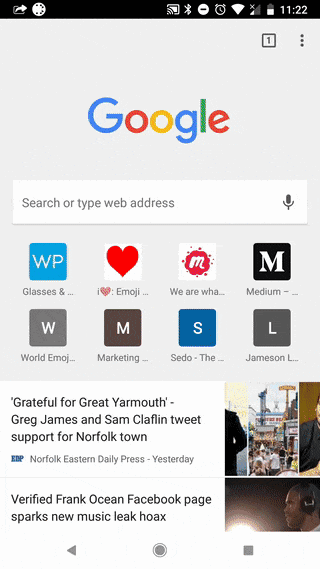
 .ws for Warby Parker
.ws for Warby ParkerYou can see how easily emoji domains work. I just selected the  emoji then added ‘.ws’ and press go.
emoji then added ‘.ws’ and press go.
Hey presto- Warby Parker! 
Smartphones are fairly easy to navigate. Most people use emoji these days and so finding the one you want won’t be hard. The section at the front of the emoji keyboard keeps your most regularly used emoji for ease of access too.
How To Type Emoji Domains On A Mac
Follow these simple steps:
- Position the cursor where you’d like the emoji to appear
- Use the following keyboard shortcut: Command Control Space bar
- Click on the emoji you’d like to insert
- Add ‘.ws’ and press GO!
- It’s as simple as that
How To Type Emoji Domains On A PC
Follow these simple steps for use on Windows 10:
- Position the cursor where you’d like the emoji to appear
- Use the following keyboard shortcut: WIN + .
- Click the smiley icon next to the left of the space bar
- Click on the emoji you’d like to insert
- Add ‘.ws’ and press GO!
If All Else Fails…
Follow these simple steps if the emoji keyboards do not work for you:
- Open emojipedia.org
- Type the name of the emoji into the search bar
- Choose from the list
- Click the ‘copy’ button to the right of the emoji
- Paste the emoji
- Add ‘.ws’ and press GO!
This last step is long-winded but is an option if you really need to type that emoji domain when all else fails.
The important thing to remember, of course, is that generally manufacturers and software providers are making it easier and easier to implement emoji across desktop and mobile devices. They realize that society has embraced emoji and won’t accept tech with a poor emoji experience.
The same goes for social platforms and messaging apps. They all accept emoji usage but because emoji domains are so new you’ll need to be guided where they work best.
A Guide to Using Emoji Domains
OK- you’ve registered a beautiful new emoji domain. Let’s say you chose to quit whatever you’re doing and become dedicated to the pursuit of tracking alien monsters  .ws
.ws
On day 1 you lucked out and discovered, for the first time in known human history, a species of alien monsters just down the road from where you live.
You’re excited
You need to tell the world.
You start with Twitter
BIO
You can use emoji domains in two places in the bio. In the about section and as the website link.
In the back-end you need to approach them differently though.
To activate both you need to type them a certain way as shown in the image below:
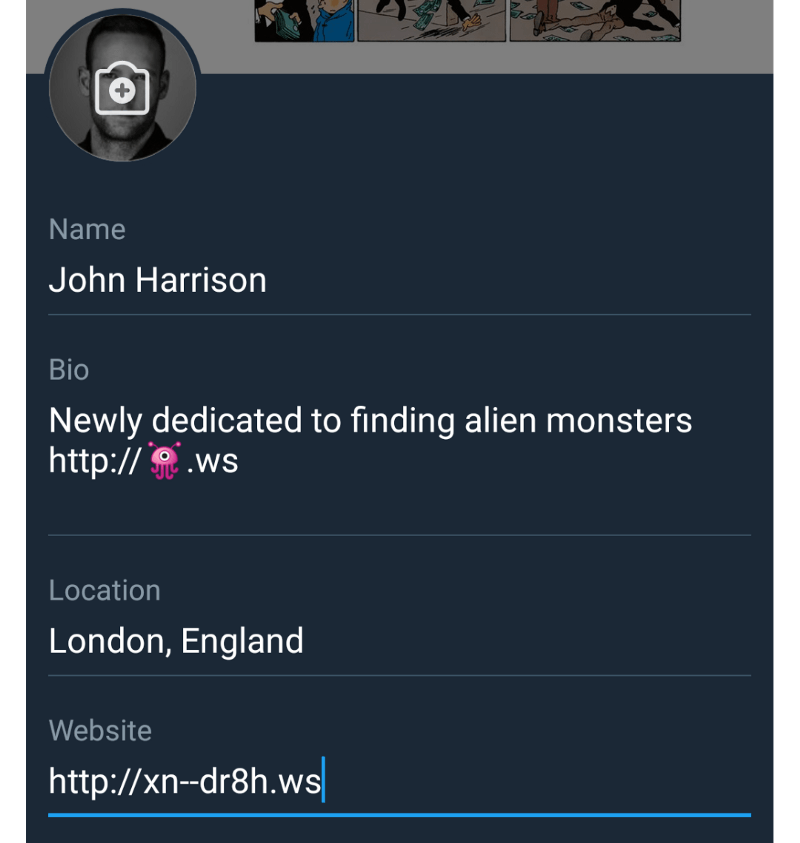
When you save the changes you’ll see them looking like normal links in the front-end like the picture below:
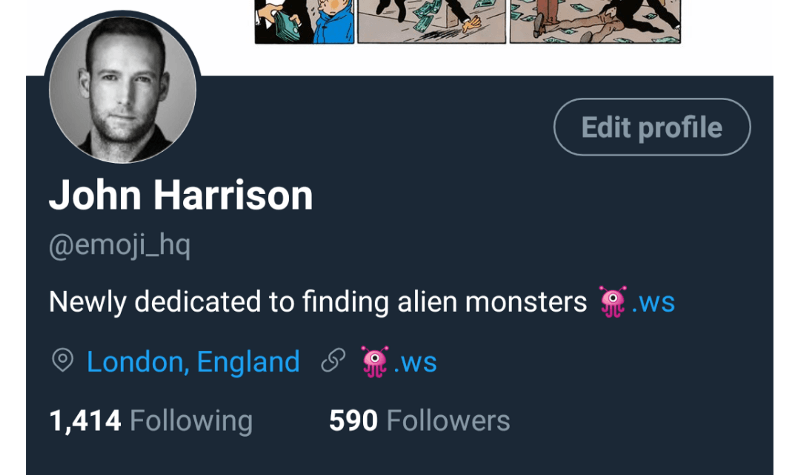
If it seems complex remember this is the trade-off for being an early adopter. We already know that software and platforms are engaged to make it easier for emoji usage. It’ll only be a matter of time until emoji domains become easier to use. The best part is you’ll already be an expert!
PRO TIP!
If you return to the back end of the profile section you’ll find that Twitter automatically removes the ‘http://’ from the ‘about’ section.

You’ll need to re-add this to activate the link. It shouldn’t be too problematic though because you’re unlikely to be changing your profile regularly enough for it to become a nuisance.
TWEET
A tweet works much the same as the profile section. Once again you need to add the ‘http://’ to activate the link which then disappears once the tweet is sent.
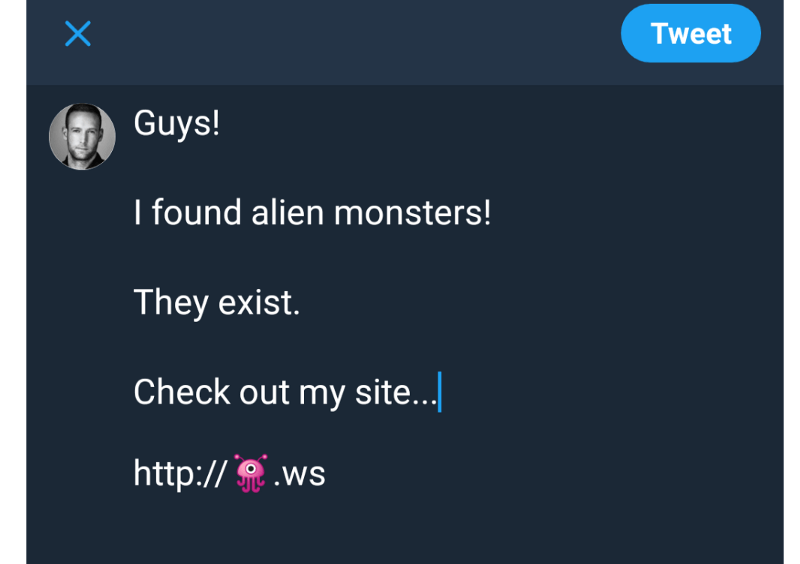
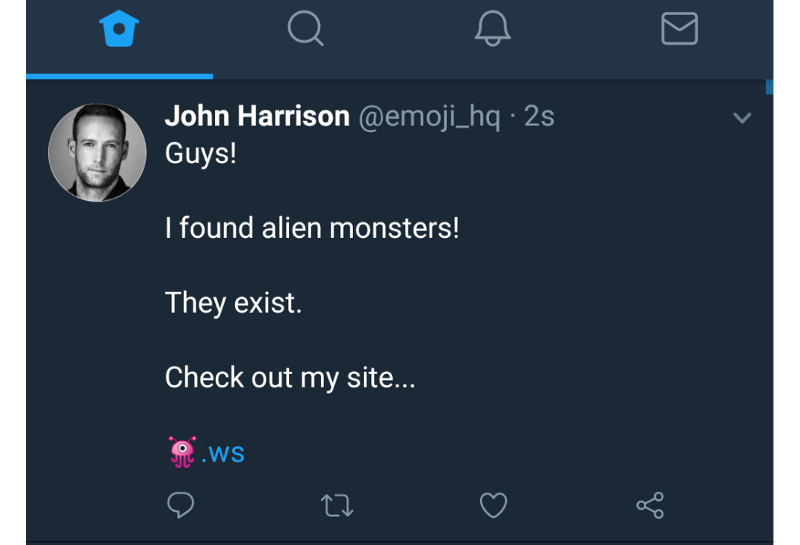
Facebook Messenger
To send an emoji domain in a Facebook Messenger message you have to write it in this format:

The published message will retain the ‘www’ and will link out. Check out the result below:

On Linkedin the website link in the profile section accepts emoji domains in the easiest way possible. This will surely be the adopted way for software, platforms and apps in the future.
In the back-end you simply add the emoji domain in its purest form:

In its published form it links out and looks like this:

WhatsApp works neatly too.
You can send emoji domains in their purest form here too.
But here’s the caveat- there is a discrepancy as to whether they link out depending on which operating system you use.
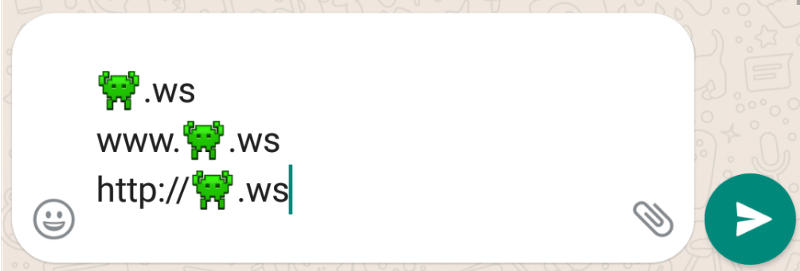

 .ws will link out from an android phone but not from an iPhone.
.ws will link out from an android phone but not from an iPhone.

www. .ws will link out from both.
.ws will link out from both.
Currently it makes sense to use www. .ws when sending emoji domains across WhatsApp, just in case your friend, customer or audience are using iPhones.
.ws when sending emoji domains across WhatsApp, just in case your friend, customer or audience are using iPhones.
The Last Word
Now you know the following things:
- Why emoji domains are only now coming to light.
- How punycoding works and how to get that code if you need it.
- Which major companies already own emoji domains.
- How to think about choosing an emoji domain for your business.
- 8 reasons why we think emoji domains are valuable to marketers.
- How to type emoji domains on a mobile, Mac and PC.
- Where on social media and messaging apps emoji domains work best.
Get in touch if you have any questions. We’d love to hear how you get on with your new emoji domains!
 .WS Emoji Domains
.WS Emoji Domains


 .ws
.ws
 ”
”




